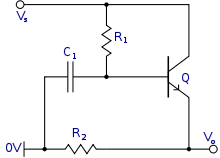Capacitance multiplier
A capacitance multiplier is designed to make a capacitor function like a capacitor that is much larger. This can be achieved in at least two ways.
- An active circuit, using a device such as a transistor or operational amplifier
- A passive circuit, using autotransformers. These are typically used for calibration standards. The General Radio / IET labs 1417 is one such example.
Capacitor multipliers make low-frequency filter and long-duration timing circuits possible that would be impractical with actual capacitors. Another application is in DC power supplies where very low ripple voltage (under load) is of paramount importance, such as in class-A amplifiers.
Transistor based

Here the capacitance of capacitor C1 is multiplied by the transistor's current gain (β).
R1 and C1 form a low-pass filter and help smooth any ripple in VS. R1 supplies the charging current as well as the transistor's (denoted by Q) base current. R2 is the load on the circuit. Without Q, R2 would be the load on the capacitor and C1 would have to be very large to maintain low ripple. With Q in place, the loading imposed upon C1 is simply the load current reduced by a factor of β. Conversely, C1 appears "multiplied" by a factor of β to the load.
Note that this circuit is not a voltage regulator, since the output voltage varies directly with the input VS. The output voltage is about 0.65V less than the base voltage, which in turn is about 2–3 V less than VS (when loaded). Larger values of R1 (and C1) reduce the output ripple to almost negligible levels. On the downside this causes the output to rise slowly towards the required value (especially when the load is connected), due to the larger time constant of R1 and C1.
Operational Amplifier based

Here, the capacitance of capacitor C1 is multiplied by the ratio of resistances C = C1 * R1 / R2, if looking into the Vi node.
Autotransformer based
These achieve a high accuracy (approximately 0.25%) at large values of capacitance (e.g. 1 F), by multiplying the capacitance of a lower value precision capacitor by the use of two transformers.
References
- Capacitance multiplier for power supplies on ESP web-site
- Capacitance multiplier (OpAmp)
- Java Applet that shows an animated capacitance multiplier
- Transistor capacitance multiplier with design details
- IET Labs 1417 FOUR-TERMINAL CAPACITANCE STANDARD